Winchester Landmarks and Monuments
(Winchester, Hampshire, England, UK)
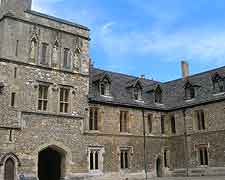
The Cathedral Close is where a number of Winchester's old landmarks and buildings reside, dating back to the period when the famous cathedral also functioned as a priory. Here you will find characterful buildings, such as the 13th-century Deanery, while close by, the 15th-century Cheyney Court is another Winchester landmark of note.
Further historical buildings in the city include the beautiful Guildhall, the Hospital of St. Cross and Winchester College. Nearby, the former grandeur of Wolvesey Castle is easy to picture from its ruins, since much of its original structure is still standing. The remains of Wolvesey Castle are now owned by the English Heritage organisation and the current bishop lives next door, in the adjacent palace.
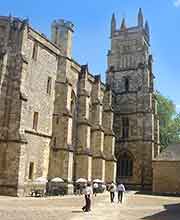
Winchester College
Address: College Street, Winchester, Hampshire, SO23 9NA, England, UK
Tel: +44 01962 621100
The oldest of England's exclusive public schools, Winchester College is very famous, being founded by Bishop Wykeham as long ago as 1382, in order to educate a group of poor scholars destined to devote their lives to religion. A school for boys only, the college is now called home by almost 700 students and a staff of approximately 100. The majority of the buildings date from the 14th century, such as the Gothic Chapel, and are in excellent condition, being well looked after over the years. A little newer is the 17th-century school room, constructed in red brick and boasting an ornate facade, with ornamental stone swags. Regular guided tours tend to concentrate on the most interesting medieval features, such as the courtyards, the Chamber Court, the gatehouse, the original cloister, and the College Hall, which was once the dining room of the scholars. The River Itchen runs close by and forms the college's 'Water Meadows'.
Open hours: walk-in guided tours, Monday, Wednesday, Friday and Saturday - 10:45, 12:00, 14:15 and 15:30, Tuesday and Thursday - 10:45 and 12:00, Sunday - 14:15 and 15:30
Admission: charge, discounts for students and seniors, children are free
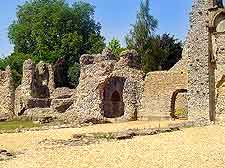
Wolvesey Castle and Palace
Address: College Street, Winchester, Hampshire, SO23 9NB, England, UK
Tel: +44 01962 854766
Wolvesey Castle was built in the early 12th century and although today the castle is in ruins, this is still a very impressive landmark. Located on College Street and alongside the River Itchen, Wolvesey Castle was once the home of Henry of Blois - the Bishop of Winchester, and has been the setting for numerous important local historical events, such as sieges during the 'Anarchy' civil war, the wedding breakfast of Queen Mary and Philip II of Spain in 1554, and its ultimate destruction during the English Civil War of the mid-17th century. Interesting, Wolvesey Castle earned its name after the story of a Saxon king, who demanded to be paid each year with the heads of 300 wolves.
Open hours: April to early October, daily - 10:00 to 17:00
Admission: free
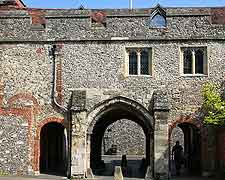
St. Swithun's upon Kingsgate
Address: Colebrook Street, Winchester, Hampshire, SO23 9LH, England, UK
Tel: +44 01962 849434
St. Swithun's upon Kingsgate is a rather unusual local landmark, being situated directly above the Kingsgate arch, which is just one of two surviving medieval gates still standing in the city. The church itself is quite unique and easily missed. Step inside and you will discover that the quiet interior is relatively plain and simple, with little in the way of features. Visitors are always welcomed, particularly during the occasional church services, and although there is no admission charge, donations are gratefully received.
Open hours: daylight hours, regular parish services
Admission: free
St. Mary's Abbey / Nunnaminster
Address: High Street, Winchester, Hampshire, England, UK
Although there may be little of St. Mary's Abbey still visible today, during the reign of King Alfred the Great (871 to 899) this nunnery was actually England's principal university. During the middle ages, the universities of
Cambridge and
Oxford came to prominence and St. Mary's Abbey was soon overshadowed somewhat, finally being dissolved by King Henry VIII in 1536. These interesting remains are contained in an enclosure sited just off the High Street, in the city centre.
Open hours: daily
Admission: free
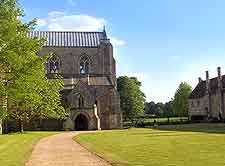
Hospital of St. Cross
Address: St. Cross Road, Winchester, Hampshire, SO23 9SD, England, UK
Tel: +44 01962 851375
The medieval Hospital of St. Cross and Almshouse of Noble Poverty is one of the city's most important historical landmarks and dates back to the early part of the 12th century. Comprising two quadrangles, the hospital also has an outer gateway, brewhouse, kitchen, guest wing, porter's lodge, tower, apartments, church and the Brethren's Hall. Highlights include 19th-century stained-glass windows, historic wall paintings, stone vaulted ceilings and beautiful views. Upon arrival, visitors receive the 'Wayfarer's Dole' - a piece of bread and a small cup of beer.
Open hours: April to October, Monday to Saturday - 09:30 to 17:00, Sunday - 13:00 to 17:00; November to March, Monday to Saturday - 10:30 to 15:30 - Sunday - parish services only
Admission: charge, discounts for children under 13 years old, students and seniors
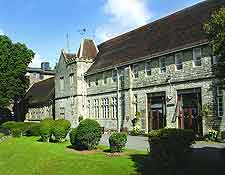
University of Winchester
Address: Milnthorpe Lane / Sparkford Road, Winchester, Hampshire, SO22 4NR , England, UK
Tel: +44 01962 841515
Formerly the Winchester Diocesan Training School and founded in 1840, the University of Winchester was later named King Alfred's College and finally achieved its university status in 2005. Home to more than 5,000 students, the university is divided into the faculties of arts, humanities and social sciences, business and law, and health and education. The purpose-built King Alfred campus forms the main grounds and lies near to the city centre. Closely linked is the city's Winchester School of Art on Park Avenue, which is actually a part of the University of Southampton.
Open hours: daily
Admission: free
 The Cathedral Close is where a number of Winchester's old landmarks and buildings reside, dating back to the period when the famous cathedral also functioned as a priory. Here you will find characterful buildings, such as the 13th-century Deanery, while close by, the 15th-century Cheyney Court is another Winchester landmark of note.
The Cathedral Close is where a number of Winchester's old landmarks and buildings reside, dating back to the period when the famous cathedral also functioned as a priory. Here you will find characterful buildings, such as the 13th-century Deanery, while close by, the 15th-century Cheyney Court is another Winchester landmark of note.



